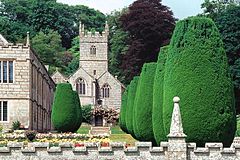Lanhydrock
Lanhydrock
|
|
|---|---|
 Lanhydrock church |
|
| Lanhydrock shown within Cornwall | |
| Population | 186 (Civil Parish, 2011) |
| OS grid reference | SX |
| Civil parish |
|
| Unitary authority | |
| Ceremonial county | |
| Region | |
| Country | England |
| Sovereign state | United Kingdom |
| Postcode district | PL30 |
| Dialling code | 01208 |
| Police | Devon and Cornwall |
| Fire | Cornwall |
| Ambulance | South Western |
| EU Parliament | South West England |
| UK Parliament | |
Lanhydrock (Cornish: Lannhedrek, meaning "church enclosure of St Hydrock") is a civil parish centred on a country estate and mansion in Cornwall, United Kingdom. The parish lies south of the town of Bodmin and is bounded to the north by Bodmin parish, to the south by Lanlivery parish and to the west by Lanivet parish. The population was 171 in the 2001 census. This increased to 186 in the 2011 census. The Parish Council meets every two months in Lanhydrock Memorial Hall.
Lanhydrock ecclesiastical parish is in the Deanery and Hundred of Pydar and in the Bodmin Registration District. The parish is in the Diocese of Truro and is now part of the Bodmin Team Ministry.
The parish church is dedicated to St Hydroc and stands in the grounds of Lanhydrock House. Parts date back to the late 15th century and the church has a chancel, nave, north and south aisles and three-stage battlemented tower with nine bells. Eight bells date from the late 19th century and are regularly rung. The ninth bell dates from circa 1599 and is only rung infrequently for tolling.
The great house stands in extensive grounds (360 hectares or 890 acres) above the River Fowey and it has been owned and managed by the National Trust since 1953. Much of the present house dates back to Victorian times but some sections date from the 1620s. It is a Grade I listed building and is set in gardens with formal areas. The hill behind the house is planted with a fine selection of shrubs and trees.
Lanhydrock estate belonged to the Augustinian priory of St Petroc at Bodmin but the Dissolution of the Monasteries during the 1530s saw it pass into private hands. In 1620 wealthy merchant Sir Richard Robartes acquired the estate and began building Lanhydrock House, designed to a four-sided layout around a central courtyard and constructed of grey granite. Robartes died in 1624 but work on the building was continued by his son John Robartes, 1st Earl of Radnor, a notable public figure who served as Lord Privy Seal and Lord President of the Council.
...
Wikipedia

